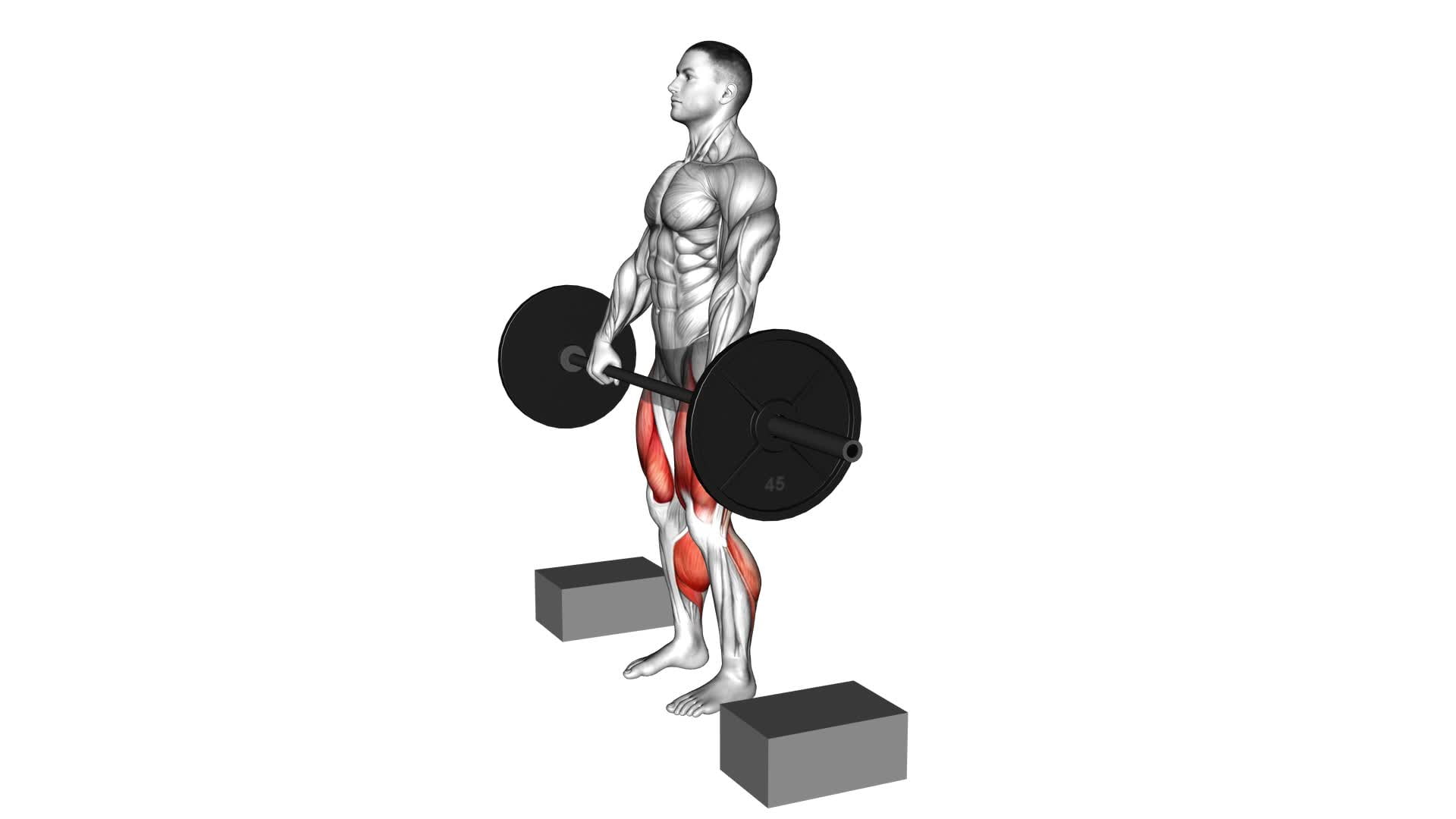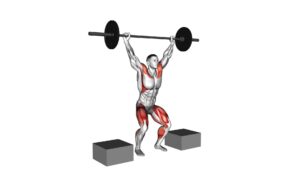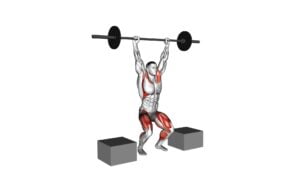Barbell Deadlift From Blocks – Video Exercise Guide & Tips

Are you looking to take your deadlifts to the next level?
Watch This Exercise Video
In this video exercise guide, we'll show you how to perform the barbell deadlift from blocks with proper technique and form. By using blocks, you can increase the intensity of the exercise and target specific muscle groups.
We'll also cover common mistakes to avoid and provide safety tips to ensure you get the most out of this challenging exercise.
Let's get started!
Key Takeaways
- Barbell deadlift from blocks targets glutes, hamstrings, quadriceps, and lower back muscles.
- Proper technique includes maintaining a neutral spine, engaging the core, and positioning the barbell at mid-shin level on blocks.
- Common mistakes to avoid include rounding the back, lifting with the arms instead of using legs and hips, and neglecting proper form and technique.
- Progression and intensity can be achieved by adding weight plates, adjusting the height of the blocks, modifying the tempo of lifts, and gradually challenging oneself while prioritizing proper form and technique.
Benefits of the Barbell Deadlift From Blocks
You will experience increased strength and muscular development when performing the barbell deadlift from blocks. This exercise specifically targets your glutes, hamstrings, quadriceps, and lower back muscles, making it an excellent choice for overall lower body strength development. By starting the lift from blocks, you're able to lift heavier weights than you'd with a conventional deadlift, which leads to increased strength gains over time.
The barbell deadlift from blocks also provides a greater range of motion compared to other deadlift variations. This increased range of motion helps to further activate and stimulate the targeted muscles, resulting in greater muscular development. Additionally, the starting position from the blocks allows you to maintain a more upright posture, placing less stress on your lower back and reducing the risk of injury.
Incorporating the barbell deadlift from blocks into your training routine can have a significant impact on your overall strength and muscular development. It's a versatile exercise that can be modified to suit your specific goals and fitness level. Whether you're a beginner or an advanced lifter, this exercise can help you achieve your desired results. Remember to always use proper form and technique to maximize the benefits and minimize the risk of injury.
Proper Technique and Form for the Exercise
To perform the barbell deadlift from blocks with proper technique and form, focus on maintaining a neutral spine and engaging your core throughout the entire movement. This will help you protect your back and maximize the effectiveness of the exercise.
When starting the deadlift, position the barbell at mid-shin level on the blocks. Stand with your feet hip-width apart, toes pointing forward, and grip the bar with an overhand grip, slightly wider than shoulder-width apart. Keep your shoulders back and down, chest lifted, and gaze forward.
As you begin the movement, push through your heels and drive your hips forward, extending your knees and hips simultaneously. Keep your back straight and avoid rounding or arching it. It may be helpful to imagine pushing the floor away from you as you lift the barbell.
Common cues for proper technique include 'chest up,' 'squeeze your glutes,' and 'engage your lats.' These cues help you maintain a strong and stable position throughout the lift.
The barbell deadlift from blocks primarily targets the posterior chain, including the glutes, hamstrings, and lower back. It also engages the quadriceps, calves, and core muscles for stability and control.
Remember to start with lighter weights to master the proper form before progressing to heavier loads. Focus on maintaining a strong and stable position throughout the lift to reduce the risk of injury and optimize your training results.
Common Mistakes to Avoid During the Barbell Deadlift From Blocks
When performing the barbell deadlift from blocks, it's important to be aware of common mistakes that should be avoided to ensure proper form and minimize the risk of injury. Here are some tips and tricks to help you avoid these common mistakes:
- Rounded Back: One of the most common mistakes is rounding your back during the exercise. This can put excessive stress on your spine and increase the risk of injury. To avoid this, focus on keeping your back straight and engage your core muscles throughout the movement.
- Lifting with the Arms: Another mistake is relying too much on your arms to lift the barbell. The deadlift is primarily a lower body exercise, so it's essential to use your legs and hips to generate the force needed to lift the weight. Keep your arms relaxed and let them hang naturally.
- Not Breathing Properly: Proper breathing technique is crucial during the barbell deadlift. Many people tend to hold their breath or exhale at the wrong time, which can affect their stability and performance. Remember to inhale before you lift, hold your breath during the exertion, and exhale at the top of the movement.
- Incorrect Foot Placement: Placing your feet too wide or too narrow can affect your balance and reduce your power output. To find the optimal foot placement, start with your feet hip-width apart, toes pointing slightly outward. Experiment with different widths to find what feels most comfortable and stable for you.
How to Progress and Increase the Intensity of the Exercise
To progress and increase the intensity of the barbell deadlift from blocks, consider incorporating additional weight plates onto the barbell. Adding weight is one of the most effective ways to challenge your muscles and continue making progress in your strength training journey. Start by adding small increments of weight, such as 2.5 or 5-pound plates, to the barbell. As you become more comfortable and confident with the added weight, gradually increase the load to continue pushing yourself and stimulating muscle growth.
Another way to increase the intensity of the barbell deadlift from blocks is by adjusting the height of the blocks themselves. Lowering the blocks will increase the range of motion and engage your muscles in a deeper contraction. This variation can provide a new stimulus to your muscles and promote further strength gains.
Additionally, you can modify the tempo of your lifts to increase the intensity. Slow down the eccentric (lowering) phase of the movement, and then explode upwards during the concentric (lifting) phase. This technique, known as eccentric training, places greater emphasis on muscle fibers and enhances muscle recruitment.
Remember to always prioritize proper form and technique when progressing and increasing the intensity of the barbell deadlift from blocks. Gradually challenge yourself, listen to your body, and make adjustments accordingly to avoid injury and ensure consistent progress.
Safety Tips and Precautions for the Barbell Deadlift From Blocks
As you progress and increase the intensity of the barbell deadlift from blocks, it's crucial to prioritize safety and take necessary precautions to prevent injury. Here are four important safety tips and precautions to keep in mind:
- Maintain proper form: To avoid injury, it's essential to maintain proper form throughout the exercise. Keep your back straight, shoulders back, and engage your core. Avoid rounding your back or using excessive momentum while lifting the barbell.
- Warm up properly: Before starting any exercise, it's important to warm up your muscles to increase blood flow and flexibility. Perform dynamic stretches and light cardio exercises to prepare your body for the deadlift from blocks.
- Use appropriate weight: Choose a weight that challenges you without compromising your form. Gradually increase the weight as you become stronger and more comfortable with the exercise. Using too heavy of a weight can lead to improper form and potential injury.
- Proper equipment setup: Ensure that the blocks you use are stable and secure, providing a solid foundation for your deadlift. Make sure the barbell is centered on the blocks and securely fastened with collars. Double-check that the blocks are at the correct height to allow for proper range of motion.
Frequently Asked Questions
What Are the Main Muscles Targeted During the Barbell Deadlift From Blocks?
When you perform the barbell deadlift from blocks, the main muscles targeted are your hamstrings, glutes, and lower back.
This exercise is highly beneficial as it helps in building strength and power in your posterior chain. By lifting the barbell from blocks, you can focus on the initial pull and improve your overall deadlift technique.
This exercise also helps in developing grip strength and enhancing your overall athletic performance.
Can the Barbell Deadlift From Blocks Help Improve Grip Strength?
Using blocks for deadlifts can be beneficial for improving grip strength. By starting the barbell from a higher position, you can lift heavier weights and challenge your grip more.
In addition to barbell deadlifts from blocks, there are other variations that specifically target grip strength, such as the double overhand grip or using thick barbells.
These exercises help strengthen the muscles in your hands, fingers, and forearms, leading to improved grip strength overall.
How Often Should I Incorporate the Barbell Deadlift From Blocks Into My Workout Routine?
To effectively incorporate deadlift variations into your workout routine, it's recommended to include the barbell deadlift from blocks regularly.
This exercise offers numerous benefits, such as improving overall strength and power, targeting specific muscle groups, and enhancing grip strength.
By adding this exercise to your routine, you can challenge your muscles in a different way and continue to progress in your fitness journey.
Remember to consult with a professional trainer to ensure proper form and technique.
Are There Any Alternatives to the Barbell Deadlift From Blocks for Individuals With Limited Mobility?
If you have limited mobility or beginner-level fitness, there are alternatives to the barbell deadlift from blocks that you can try. These modifications can help you work your lower body without putting strain on your back.
Some options include using dumbbells or kettlebells for deadlift variations, using resistance bands for hip hinge exercises, or trying the trap bar deadlift.
Remember to consult with a fitness professional to ensure proper form and avoid injury.
Can the Barbell Deadlift From Blocks Be Modified for Beginners or Individuals With Lower Back Issues?
If you're a beginner or have lower back issues, you might be wondering if there are modified variations of the barbell deadlift from blocks that are more suitable for you. Good news! There are lower back friendly deadlift alternatives that can be used as modified variations.
These variations focus on reducing the load on your lower back while still targeting your posterior chain muscles. Let's explore these modified options and find the best fit for your needs.
Conclusion
In conclusion, the barbell deadlift from blocks is a highly beneficial exercise that targets multiple muscle groups, improves strength, and enhances overall performance. By following proper technique and form, avoiding common mistakes, and gradually increasing intensity, individuals can maximize the benefits and minimize the risk of injury.
Remember to prioritize safety by using appropriate weights, maintaining proper posture, and seeking guidance from a professional if needed. Incorporating the barbell deadlift from blocks into your fitness routine can lead to significant improvements in strength and athletic performance.

Author
Years ago, the spark of my life’s passion ignited in my mind the moment I stepped into the local gym for the first time. The inaugural bead of perspiration, the initial endeavor, the very first surge of endorphins, and a sense of pride that washed over me post-workout marked the beginning of my deep-seated interest in strength sports, fitness, and sports nutrition. This very curiosity blossomed rapidly into a profound fascination, propelling me to earn a Master’s degree in Physical Education from the Academy of Physical Education in Krakow, followed by a Sports Manager diploma from the Jagiellonian University. My journey of growth led me to gain more specialized qualifications, such as being a certified personal trainer with a focus on sports dietetics, a lifeguard, and an instructor for wellness and corrective gymnastics. Theoretical knowledge paired seamlessly with practical experience, reinforcing my belief that the transformation of individuals under my guidance was also a reflection of my personal growth. This belief holds true even today. Each day, I strive to push the boundaries and explore new realms. These realms gently elevate me to greater heights. The unique combination of passion for my field and the continuous quest for growth fuels my drive to break new ground.







